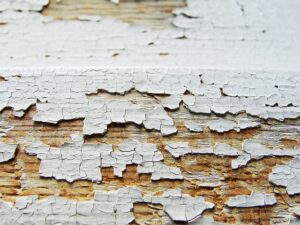Lead-Based Paint Risk Assessment: Lead-based paints were banned for residential use in 1978
Homes built in the U.S. before 1978 are likely to have some lead-based paint. When the paint peels and cracks, it makes lead paint chips and dust. Any surface covered with lead-based paint where the paint may wear by rubbing or friction is likely to cause lead dust including windows, doors, floors, porches, stairways, and cabinets. – CDC
Frequently Asked Questions About Lead
Explore our detailed FAQ section to find answers to common queries about lead. We’ve got you covered with expert insights from preventative maintenance to understanding the building health implications.
Lead-based paint, commonly used in homes before 1978, contains lead as an additive. If the paint deteriorates into dust or chips, it poses severe health risks, especially to children. Ingesting or inhaling lead particles can lead to developmental delays, learning disabilities, and behavioral problems in children.

Homes built before 1978 are likely to have lead-based paint. For accurate assessment, hire certified professionals for a lead paint inspection or risk assessment. While home test kits are available, professional testing ensures precise results vital for your safety.
Lead exposure poses significant risks. In children, it can cause developmental issues, impacting learning and behavior. Adults may experience fertility problems, high blood pressure, and other health complications, making it crucial to prevent exposure, especially in homes with lead-based paint.
Yes, it can, but it demands expertise. Certified professionals using lead-safe practices are essential for safe removal. DIY attempts can release hazardous lead dust, exacerbating the situation. Always rely on trained experts well-versed in lead abatement techniques.
Suspecting lead-based paint warrants meticulous care. Maintain well-maintained, clean areas, especially surfaces prone to friction like windows and doors. Regularly clean floors, window sills, and surfaces with a damp mop or cloth. Prevent children from chewing on painted surfaces to avoid potential lead ingestion.
Yes, encapsulation is a viable method. It involves applying a specialized coating over lead-based paint, but this should only be undertaken by professionals adhering to specific guidelines. Encapsulation effectively seals the paint, preventing the release of lead particles.
Safety depends on the condition of the paint. If it’s in good condition and not deteriorating, the risk is lower. However, it’s essential to conduct a lead inspection before purchasing older homes. Taking necessary precautions, like encapsulation or professional removal, ensures a safe living environment.
Absolutely, lead dust can be hazardous even when the paint appears intact. Everyday activities such as opening and closing windows or doors create friction, producing fine lead dust particles. These particles settle on surfaces and can be easily ingested or inhaled, posing significant health risks, particularly to children. To minimize this risk, it’s crucial to employ proper cleaning techniques, such as using damp cloths and mops, to remove dust regularly. Paying particular attention to cleaning floors, windowsills, and other painted surfaces can significantly reduce exposure.

Looking For Professional Lead Inspection in Baltimore?
Contact Us Today!
Discover how HTX Consulting can help you achieve a healthier and safer indoor environment.

